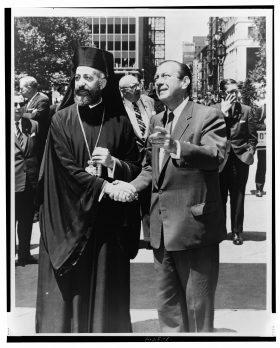The students were legally enrolled in the school. The National Association for the Advancement of Colored People (NAACP) had attempted to register students in previously all-white schools as early as 1955. The Little Rock School Board agreed to gradual integration, with the Superintendent Virgil Blossom submitting a plan in May of 1955 for black students to begin attending white schools in September of 1957. The School Board voted unanimously in favor of this plan, but when the 1957 school year began, the community still raged over integration. When the black students, known as the "Little Rock Nine," attempted to enter Central High School, segregationists threatened to hold protests and physically block the students from entering the school.
Under the pretext of maintaining order but in support of the segregationists, Arkansas Governor Orval Faubus mobilized the Arkansas National Guard to prevent the Little Rock Nine from entering the school. After a federal judge declared the action illegal, Faubus removed the troops. When the students tried to enter again on September 24, they were taken into the school through a back door. Word of this spread throughout the community, and a thousand irate citizens stormed the school grounds. The police desperately tried to keep the angry crowd under control as concerned onlookers whisked the students to safety.
The nation watched all of this on television. President Eisenhower was compelled to act.
Eisenhower was not a strong proponent of civil rights. He feared that the Brown v. Board of Education Supreme Court decision could lead to an impasse between the federal government and the states. Now that very stalemate had come. The rest of the country seemed to side with the black students, and the Arkansas state government was defying a federal decree. The situation hearkened back to the dangerous federal-state conflicts of the 19th century that followed the end of the Civil War.
On September 24, after the mayor of Little Rock asked President Eisenhower for help enforcing integration, Eisenhower ordered the troops of the 101st Airborne Division into Little Rock, marking the first time United States troops were dispatched to the South since Reconstruction. He federalized the Arkansas National Guard in order to remove the soldiers from Faubus's control. For the next few months, the African American students attended school under armed supervision. Even so, they faced physical and verbal abuse from their white peers. The Little Rock Nine were instructed, just as during the pro-segregation protests, not to respond or react to these taunts.
The following year, Little Rock School District officials under the command of Faubus closed the schools to prevent integration. But in 1959, the schools were open again. Both black and white children were in attendance.
The tide was slowly turning in favor of those advocating civil rights for African Americans. An astonished America watched footage of brutish, white southerners mercilessly harassing African American children calmly walking into school, intent on getting an education. Television swayed public opinion toward integration.
In 1957, Congress passed the Civil Rights Act, the first such measure since Reconstruction. The law created a permanent civil rights commission to assist black suffrage. The measure had little teeth and proved ineffective, but it paved the way for more powerful legislation in the years to come.





